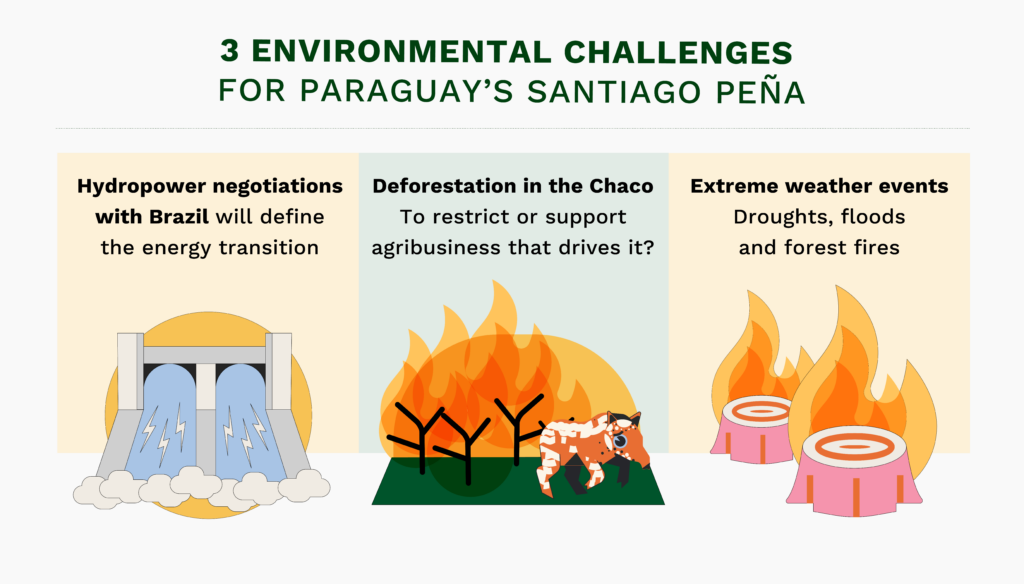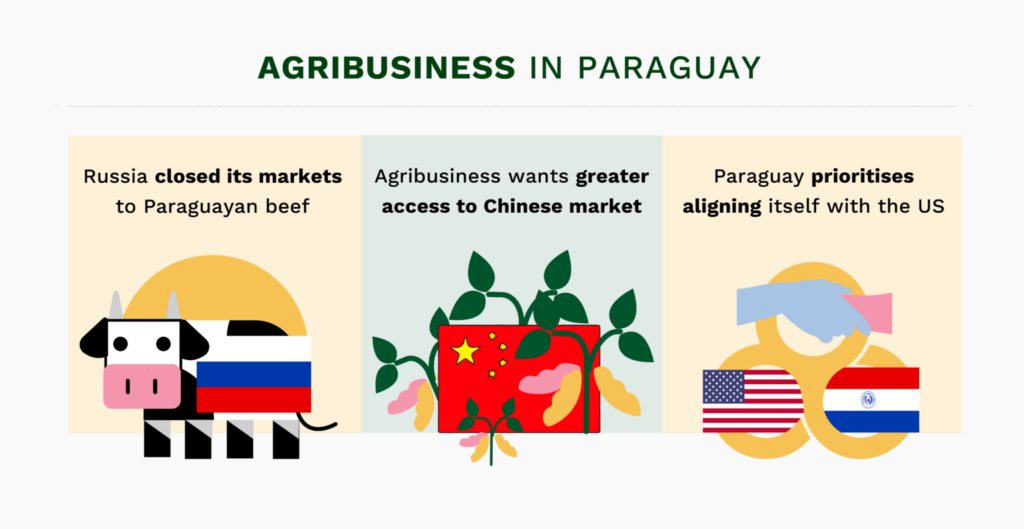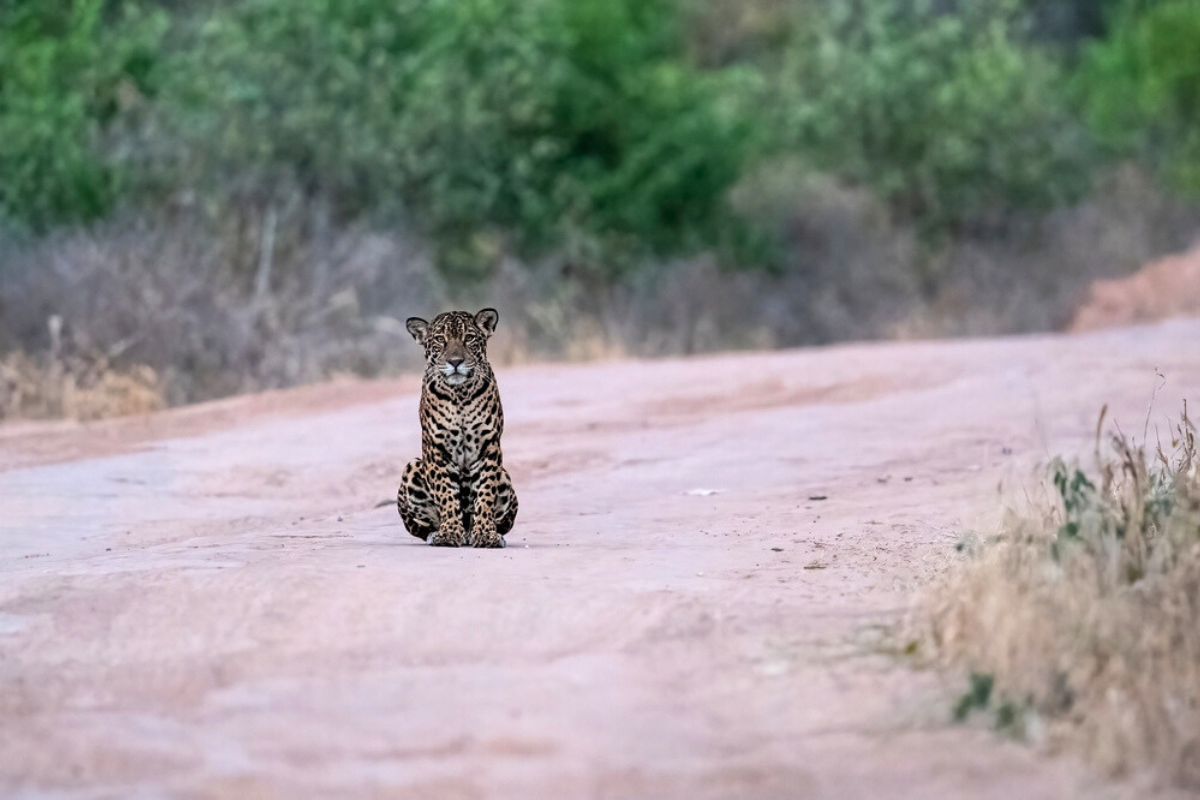When he takes office as the president of Paraguay on August 15, Santiago Peña will not be greeted with the easiest of in-trays.
The recently-elected former finance minister will be taking over a country that registered an economic contraction in 2022 as a result of its worst drought in nearly 80 years; a country that has seen a national emergency declared twice in the last five years due to forest fires; one whose main trade route, the Paraguay River, has twice broken its historic low water levels in the last three years; and a country in the midst of a silent but widespread health crisis, as heatwaves drive the spread of diseases such as chikungunya.
Mr. Peña, an economist, former International Monetary Fund official, and candidate for the right-wing Colorado Party, won with 43 percent of the vote in the April 30 elections — some way ahead of the broad coalition Concertación (28 percent) and the National Crusade (23 percent), an anti-establishment nationalist party headed by Paraguayo Cubas, who has since been arrested after instigating protests over unsubstantiated allegations of electoral fraud.
The Colorado Party, the dominant force in Paraguayan politics having governed almost without interruption for 75 years, also managed to secure a majority in both houses of Congress.
According to Camilo Filártiga, a program officer for electoral processes at International IDEA, an organization supporting global democracy, Mr. Peña was successful as “he managed to unify and discipline the party vote and put forward an effective, traditional and conservative discourse” as opposed to the “uncertainty” offered by the Concertación coalition and its candidate, Efraín Alegre.
With his comfortable election out of the way, President-elect Peña must now look ahead to confronting a range of challenges facing his nation, including growing pressures on the environment and climate.
Paraguay’s energy questions
Much like his fellow leading candidates, Mr. Peña made sparse reference to environmental issues during his election campaign, with his ambitions summarized in a single poster entitled “Paraguay Conserves.” This presented a range of broad promises, as well as references to existing policies, such as the protection of watercourses that the country depends on for trade and hydroelectricity generation.
Mr. Peña’s environmental program proposes the “strengthening” of public and private protected areas, which are impacted by illegal cannabis plantations in the country’s east, and by the expansion of cattle ranching and charcoal production, often on Indigenous lands, in the Chaco region.

The Paraguay Conserves poster also highlights the creation of an early warning system for climate risks, though this was already part of the country’s national adaptation policy for 2022–2030. This system will be important for decision-making in livestock and crop production, which suffered catastrophic losses in 2021 when it did not rain for almost a year.
These difficulties have been compounded since 2020 by waves of forest fires, linked to land clearance for agriculture and worsened by heat waves, the frequency of which has tripled in the last 40 years in Paraguay.
Mr. Peña also proposes to “promote renewable energies.” In this area, he faces the historic task of renegotiating part of an agreement struck with Brazil 50 years ago that created Itaipú, one of the world’s largest hydroelectric plants that straddles the border between the two countries on the Paraná River.
In 2022, the plant supplied 86.4 percent of all the electricity consumed in Paraguay and 8.4 percent of Brazil’s total demand.
One of the central issues of this negotiation — and one defining the energy transition of a country whose energy mix otherwise still depends on fossil fuels and biomass — is how to make use of the surplus electricity that Paraguay is entitled to from Itaipú.
Both nations are entitled to 50 percent of the generation from the plant, but Paraguay currently sells its surplus to Brazil at low prices, a point on which it hopes to negotiate a more beneficial deal.
Unlike outgoing President Mario Abdo Benítez, who indicated that discussions over the short-term details of the two countries’ agreement were a more urgent priority, Mr. Peña said “Paraguay does not need to renegotiate Itaipú to have that energy now.”
He proposes “sitting down” with Brazilian President Luiz Inácio Lula da Silva to “imagine a relationship that can last for the next 50 years.”
Guillermo Achucarro, a climate and energy policy researcher at the National University of Asunción, told Diálogo Chino that the difference in discourse between Mssrs. Abdo and Peña is not in fact significant, and that he is pessimistic about Paraguay’s potential gains from renegotiations. “If anything is achieved,” he said, “it will be crumbs.”
Mr. Achucarro questioned the way in which Paraguay’s transition away from fossil fuels towards renewable energy has so far developed, with an emphasis on large infrastructure projects that have benefited from favorable conditions offered by the government, and been surrounded by environmental and social tensions.
Omega Green is one such project. A planned biofuels factory that will be South America’s largest when it opens in 2025, it will make use of forest plantations that include Pongamia, an exotic species that could compromise the biodiversity of the Chaco region but which has been declared “native” by a state resolution.
Elsewhere, a planned green hydrogen factory led by Atome Energy, a company started by British oil firm President Energy, was greenlit during the government of former President Horacio Cartes (2013–2018) and granted access to energy at a lower tariff than the market rate.
Beyond these existing projects for green hydrogen and biomass, from which Paraguay derives just over a third of its energy, there is no indication yet of how — or if — Mr. Peña’s administration will approach renewables such as wind and solar.
These sources are so far practically non-existent in the country’s energy mix, but as the threats from drought rise due to climate change and strain hydropower output, the need to diversify generation may become more pressing.
Deforestation and agriculture
Other enduring environmental questions facing the Peña administration relate to deforestation — notably in the Chaco, a biome Paraguay shares with Argentina, Bolivia, and Brazil — and the role of the country’s agriculture sector in driving it.
Cattle ranching is the primary driver of the deforestation, both legal and illegal, that has taken place over the last decade and a half in the Paraguayan Chaco. An official report acknowledged that 667,000 hectares of the region were deforested between 2017 and 2020, 88 percent of the total deforestation recorded in the country.
Mr. Peña’s Paraguay Conserves poster mentions plans to restore areas of degraded forest and to “strengthen” national parks and nature reserves, but there has been no suggestion of concerted efforts to combat agriculture-driven deforestation.
To the contrary, as Paraguay and its Mercosur partners negotiate a new trade deal with the European Union, the president-elect has denounced environmental conditions that look to restrict products linked to forest loss, such as the EU’s new zero-deforestation sourcing law.

During the election campaign, candidates faced pressure from Paraguay’s agriculture sector over relations with China, with many unhappy that accessing the Asian nation’s large market remains challenging for the South American country’s products due to its ongoing diplomatic ties with Taiwan.
Opposition candidate Efraín Alegre openly questioned these continued relations, but Mr. Peña has ruled out a switch. He has said that this is not an obstacle to the business that Paraguay already has with China, claiming that “there are no restrictions whatsoever.”
Mr. Peña has also argued that the quality of Paraguayan commodities is already an argument to convince potential buyers. “China is not going to buy Paraguayan meat or soybeans because there is a diplomatic interest,” he said during his campaign. “It is going to buy because Paraguay has good quality meat and soybeans at competitive prices.”
Lis Garcia, an agribusiness specialist and researcher at think tank BASE-IS, told Diálogo Chino that the opening of the U.S. market for beef exports is also in process, but “it doesn’t look like it will prosper.”
One possible reason for this is allegations of labor exploitation on Paraguayan farms. The U.S. announced in March that it will fund the International Labor Organization to investigate and address these accusations.
The course that Mr. Peña takes on expanding markets for Paraguayan commodities will have implications for the country’s environment that will require careful management, but the direction of this course as yet remains unclear.
For Guillermo Achucarro, Paraguay’s main challenge in the next five years, and one that the president-elect must address, is “to survive the next extreme climatic phenomena, such as the flooding predicted for 2023. One year it rains a lot, one year it’s drought, the next summer we have forest fires and an epidemic.” The biggest question, Mr. Achucarro added, is how Santiago Peña will manage these multiple crises.
This story was originally produced by Diálogo Chino and El Surtidor.


 Search
Search






































